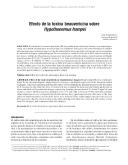| dc.description.abstract | El estudio de la toxina beauvericina (BEA) producida por Beauveria bassiana es de suma importancia en el ámbito entomológico, no solo porque este organismo forma parte del control biológico de muchos insectos plaga, sino también porque este tipo de biomoléculas tóxicas participa activamente en los mecanismos de infección de hongos entomopatógenos. En este estudio, se evaluó el efecto de la BEA sobre larvas de primer instar y adultos de Hypothenemus hampei, por inmersión y aplicación tópica, respectivamente, utilizando concentraciones de 25,50 y 75 ng/ml de toxina al 1,3 y 5 día. Los bioensayos se incubaron en un cuarto climatizado, a 27°C ¦ 1° y HR de 75 - 80 por ciento, y se realizaron evaluaciones diarias de mortalidad y desplazamiento de los individuos. Los resultados muestran que no hubo diferencia estadística significativa en el efecto de la toxina sobre adultos, pero sí en los efectos sobre larvas de primer instar. Se sugiere que la acción de la BEA fue más activa en larvas que en adultos alcanzando mortalidades inferiores al 10 por ciento al día 1 de evaluación, mayores al 30 por ciento para los días 3 y 5, y superiores al 50 por ciento al día 8. Beauvericin (BEA) is a toxin produced by the entomopathogenic fungus Beauveria bassiana, a pathogenic agent used in the biological control of plagues. It has been demonstrated that this toxin is involved during the infection process of the host insect by B. bassiana. In this study, the effect of beauvericin was evaluated by immersion and topical application on larvae and adults of Hypothenemus hampei, respectively, by using concentrations of 25,50 and 75 ng/ml of toxin in days 1,3 and 5. The bioassays were incubated at 27 ¦ 1°C and a RH of between 75-80 percent. Mortality and individual displacement were evaluated daily. Results did not show significant statistical difference of the toxic effect on adults, but effects on first instar larvae were detected. These results suggest that the toxic effect of BEA was more effective on larvae than on the adults, showing a mortality rate of less than 10 percent on day 1, more than 30 percent on days 3 and 5, and more than 50 percent on day 8. | es_ES |


